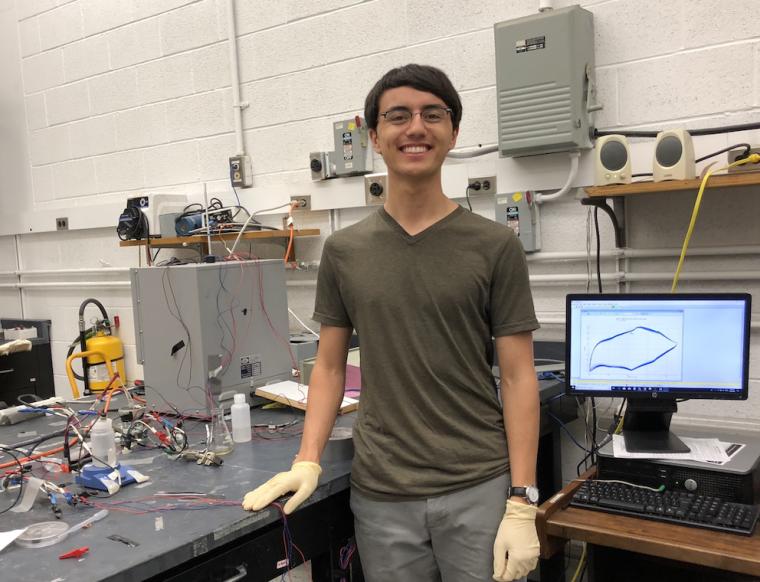In Search of Renewable Energy, Andrew Santiago ’20 Brings Plenty of His Own
July 25, 2018
Amanda Nagy

Andrew Santiago is doing summer research on sodium ion batteries the Department of Materials Science and Engineering at Carnegie Mellon University.
Photo credit: Courtesy of Andrew Santiago
During the academic year, double-degree student Andrew Santiago manages a rigorous schedule that allows him to take lessons in flute performance while majoring in chemistry and physics. This summer is no exception: When he isn’t working on developing a new electrode material for aqueous sodium ion batteries in the Department of Materials Science and Engineering at Carnegie Mellon University, he can be found in the practice rooms in the Carnegie Mellon School of Music.
Santiago is taking full advantage of his surroundings as an intern with the research group led by Jay Whitacre ’94, an innovator in the field of renewable energy technology. Whitacre is director of the Wilton E. Scott institute for Energy Innovation at Carnegie Mellon and founder of Aquion Energy, a venture focused on a novel energy storage system.
Santiago was first introduced to Whitacre through a shared connection—his advisor, Professor of Physics John Scofield, was also Whitacre’s advisor at Oberlin. With Scofield’s help, Santiago solicited Whitacre for his 2018 winter-term project, which was focused on renewable energy, and he spent the month of January working in his lab. Santiago says he was invited to return this summer.
“Generally, what I’m looking to work on is creating accessible renewable energy,” says Santiago, a fourth-year who is from Evanston, Illinois. Saltwater batteries—the product manufactured by Aquion Energy—are safer and more sustainable than the ubiquitous lithium ion batteries, but they currently have a much lower storage capacity. Santiago explains that he’s developing a new material for the electrode, the part of the battery that stores energy.
“Improving the charge capacity of the electrodes can directly improve the quality of the battery. I'm trying to optimize a material so that it offers high charge capacity and long cycle life, so that the battery can store more energy and be used for a longer period of time without failing and needing to be replaced.”
Santiago says he has learned hands-on work and received mentoring from the doctoral students in the lab.
“They’ve all been incredibly helpful and generous with their time to guide me through things. The most frustrating thing about this work is that it takes a lot of time. The synthesis takes around 19 hours and most of the electrochemical tests I do take at least two days to complete, so there's a lot of down time. The work has been going well with few hiccups. We’re working on adapting a material which [Whitacre’s] group has already studied quite a bit, and the results are looking very promising so far.”
Santiago has also enjoyed spending time in Pittsburgh, taking in the city’s festivals, and making the most of the Carnegie Mellon campus. “I'm very thankful that I’ve been able to use the School of Music’s facilities to practice and prepare for my senior recital in the fall.”
At Oberlin, Santiago is a member of the Filipinx American Students Association, a chemistry tutor and lab teaching assistant, and he is the first-year liaison for Queer and Formal Reasoning, Oberlin’s student organization for LGBTQ students in the sciences.
You may also like…
Josh Nolan Named Vice President, General Counsel, and Secretary at Oberlin
Distinguished attorney brings extensive experience in higher education law.
Learning by Teaching: Oberlin Students Share Global Music with Young Learners
College and Conservatory students in PACE 103 prepare local children for an immersive community concert at Oberlin.
Nuiko Wadden ’02 Joins Oberlin Conservatory Faculty as Assistant Professor of Harp
The versatile musician brings extensive opera, orchestral, and contemporary music experience to her role


